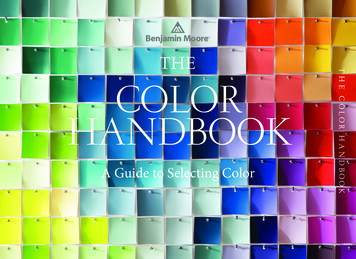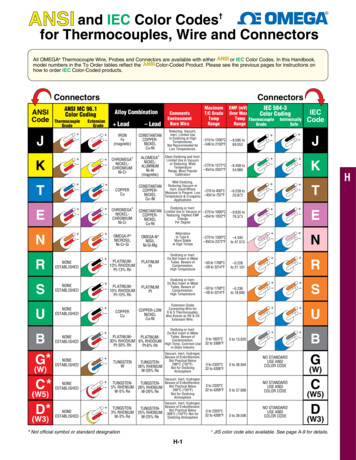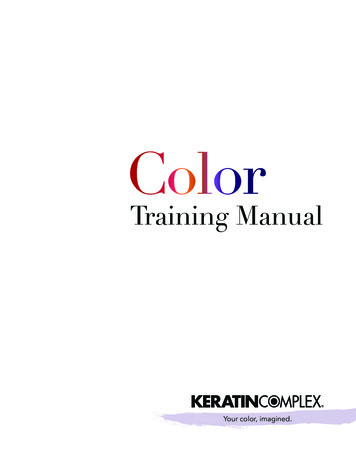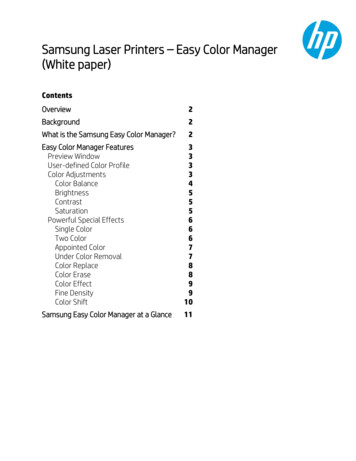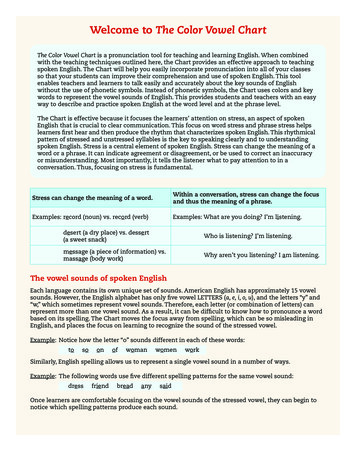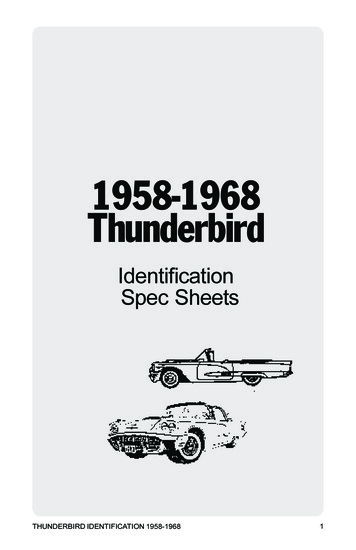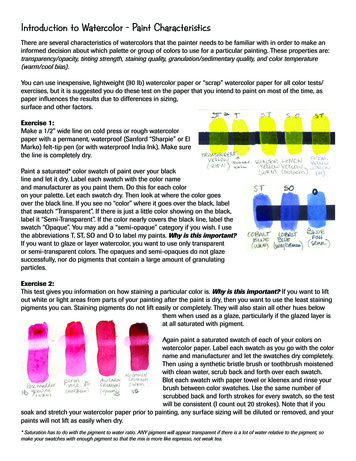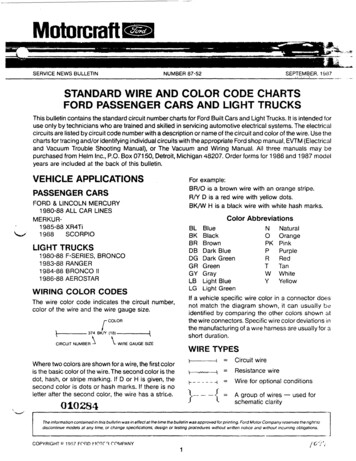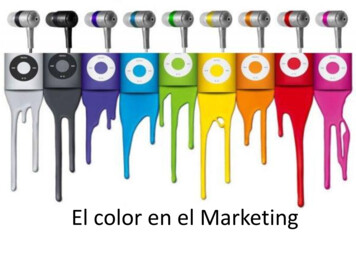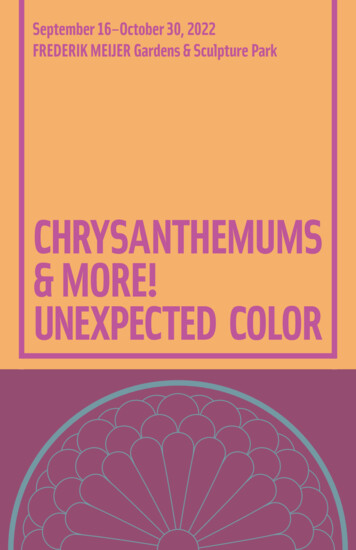
Transcription
September 16–October 30, 2022FREDERIK MEIJER Gardens & Sculpture ParkCHRYSANTHEMUMS& MORE!UNEXPECTED COLOR
The chrysanthemum is coming to life in the fall,while most plants are fading and preparingfor winter. This year’s exhibition aims to surpriseand delight, with a focus on abundant autumnplantings arranged in intriguing and uncommoncolor combinations. Both artful and natural, thepalette of vivid complementary colors and subtletone-on-tone pairings—bringing awareness totexture and shape—is sure to pique your interestand catch your eye.As you explore the gardens and grounds, indoorsand out, take special note of the locations listedbelow to appreciate all the rich and striking detailof Unexpected Color.
645312E EEExhibition Map123456BISSELL CorridorGrace Jarecki Seasonal Display GreenhouseGateway GardenDoehne Wildflower MeadowGwen Frostic Woodland Shade GardenMichigan’s Farm Garden
BISSELL CorridorView new and unique arrangements created by adifferent local florist each week. Special thanksto these florists for their generous donations.Hayley Hungerford, Hyssop FloralHorrocks MarketBrennan Smith, Big City VibesKennedy’s Flowers & GiftsMeijer Gardens Horticulture StaffMelissa Snoeyer,Dahlia Acres FarmsBrenda Hankis, Eastern Floral
Grace Jarecki SeasonalDisplay GreenhouseThe chosen color palettes for the annualhorticulture exhibitions are first andforemost influenced by our horticulturist’srecommendations and plant availability andthen refined for various exhibition applications,materials, and multimedia campaigns. Thisyear’s Chrysanthemums & More! color paletteis a combination of two color schemes thattogether present the season in unexpected waysby applying color theory.Complementary colors are colors across fromeach other on the color wheel, like blue andorange. See: blue green kale paired with orangemums and orange pumpkins.Analogous colors are colors next to each otheron the color wheel, like blue, purple and pink.See: periwinkle blue asters, dark purple kalesand bright pink mums.
Gateway GardenUnexpected Color is realized from theChrysanthemums to the More! as you take inthe beauty of fall while passing through theGateway Garden. See the garden beds come alivewith this fresh take on the chrysanthemum colorpalette. The pairing of analogous colors, like pinkand purple, alongside the complementary colorpairing of purple and orange create a uniquevisual experience.
Gateway GardenCelebrate the More! by appreciating the widediversity in color and form of kale and cabbage.Beautiful bluegreen foliage is on display with theruffled leaves of the Winterbor kale andthe strap-like, savoyed leaves of lacinato kale.Visit throughout the season to see unexpectedfall color change; the deep purple-red leavesof the Redbor kale and purple of the Nagoya‘Red’ kale intensify as the temperatures drop.Contrasting foliage textures—like the beautiful,wavy edged leaves of Osaka ‘Red’ cabbage and thefeathery, frilled leaves of Peacock ‘Red’ floweringkale—provide additional visual interest in thisgarden. Together, both the Chrysanthemums andthe More! serve as an anchor and a key unifyingelement across the outdoor exhibition plantings.What other complementary and analogous colorpairings can you find in these garden beds?
Doehne Wildflower MeadowThe Chrysanthemums & More! theme forthis year, Unexpected Color, creates anelement of visual surprise, utilizing specialtychrysanthemums, cabbage, kale, asters andmore in unexpected ways through the carefulapplication of color theory. Thoughtfulobservation of the Doehne Wildflower Meadow,however, reveals this theme from a perspectiverooted in the natural environment andMichigan’s own native plants. As you look outinto the Wildflower Meadow, take in the richchrome yellow of goldenrod growing alongsidethe striking royal purple of New England aster.
Doehne Wildflower MeadowIn her book Braiding Sweetgrass, Dr. RobinWall Kimmerer reflects on the art and scienceof how these wildflowers are paired togetherin nature. Aesthetically, purple and yellow arecomplementary colors—across from each otheron the color wheel and as different from oneanother as can be. The striking contrast of thesecomplementary colors causes them to appearmore vivid when paired together, creatinga dazzling natural fall color palette. Thereare important ecological implications to thispairing as well. This visual contrast similarlymakes goldenrod and asters more attractive tobees; goldenrod and asters are visited by thesepollinators more often when they grow togetherthan when they are apart. The natural, elegantpairing of goldenrod and asters in fall is aperfect example of what Dr. Kimmerer calls livedreciprocity—“wisdom that the beauty of one isilluminated by the radiance of the other.”
Glow GardenGWEN FROSTIC WOODLAND SHADE GARDENTuesdays, September 20, 27, and October 4,5–8:30 pm Music and Food 5:30–8 pmThe Woodland Shade Garden transforms intothe Glow Garden, its natural beauty enhancedthrough the power of light. Enjoy artfully carvedpumpkin displays by Grand Rapids printmakerAlynn Guerra, decorative lanterns, log lights,and glowing trees.
Tuesdays at the FarmMICHIGAN’S FARM GARDENTuesdays, September 20, 27, and October 4,5–8:30 pm Music and Food 5:30–8 pmEat, drink and dance in the crisp autumn air!The James & Shirley Balk Café pop-up will servefresh local fare along with West Michigan beerand adult cocktails while guests enjoy live localmusic. It’s a great time for everyone wanting toexperience fall at Meijer Gardens.
EventsOnce you’ve seen our chrysanthemums, maketime for the More! Enjoy fall festivities withfun for the whole family. All events are includedwith admission. FALL BONSAI SHOW Saturday, October 1, 10 am–5 pmSunday, October 2, 11 am–5 pmSee a variety of bonsai on display, from treesin early training stages to mature older trees.Watch bonsai artists at work and shop for bonsaitrees, tools, and supplies.PRESENTED BY THE WEST MICHIGAN BONSAI CLUB HALLOWEE-ONESFriday, October 21, 10 am—12 pmGet creative at this special event designed for ouryoungest visitors. Dress your child as a sculpture,mammal, fish, insect, bird, tree, flower, geologistor in any other way that highlights somethingabout the Lena Meijer Children’s Garden. CelebrateHalloween with your wee ones as you listen toHalloween-themed stories and go on a Halloweenthemed hunt. No tricks. No treats. Just fun! Paradebegins at 10:15 am.
Unexpected ColorLecture SeriesUNEXPECTED COLOR IN NATURE Sunday, September 25, 2–3 pmJoin us as we experience how Unexpected Colorreveals itself in nature. Take a walk with EveChoi, Curator of Horticultural & EnvironmentalEducation, to observe the natural colors reflectedin the Doehne Wildflower Meadow plantings inautumn. See how the plants pairings can haveboth ecological importance and aesthetic beautyrooted in color theory, and learn more about thescience behind fall color change. UNEXPECTED COLOR IN DESIGN Sunday, October 9, 2–3 pmJoin us as we take a closer look at the inspirationbehind the Unexpected Color theme with AmberOudsema, Curator of Arts Education. Learn thebasics of color theory and see how it has beenartfully applied in this year’s Chrysanthemums& More! exhibition theme and displays. Then tryout what you’ve learned in a hands-on activityexploring the principles of color theory. UNEXPECTED COLOR IN FLORAL DISPLAYSSunday, October 23, 2–3 pmJoin us as we explore Unexpected Color on aguided tour of the Welcome Center and BISSELLCorridor indoor plantings and floral displays.Elizabeth Wesley-Martin, Meijer Gardens Floristand Horticulturist, will explain her approachto floral design and highlight key plantings ondisplay throughout the Main Building. Learnthe basics of floral design and observe howUnexpected Color is beautifully realized throughthe indoor Chrysanthemums & More! displays.
Color TheoryThis year’s Chrysanthemums & More! color paletteis a combination of two color schemes that—byapplying color theory—together present the seasonin unexpected ways. Color theory is a set ofprinciples that helps explain the science behindcolor mixing and why certain color combinationswork better than others. Color theory is explainedvisually with a color wheel made up of primary,secondary and tertiary colors.
YellowOrangeYellowenGreowYellngeOraGreenBlue GreenRed OrangeRedplePurRedPurpleBlue PurpleeBluThree primary colors—red, blue and yellow—canbe used to create all other colors when mixed inparticular combinations.Purple, green and orange are secondary colors,which result from mixing two primary colors.Red Blue Purple.Blue Yellow Green.Yellow Red Orange.Tertiary colors are red orange, red purple,blue purple, blue green, yellow green andyellow orange, which result from mixingprimary and secondary colors next to eachother on the color wheel.
CHRYSANTHEMUMS& MORE!UNEXPETED COLORis made possible by the generous support of:The Meijer FoundationFrederik Meijer Gardens& Sculpture FoundationBotanic and Sculpture Societiesof Frederik Meijer Gardens& Sculpture ParkMichigan Arts and CultureCouncil, a partner agency of theNational Endowment for the ArtsTownsquare Media
FREDERIK MEIJER Gardens & Sculpture Parkpromotes the enjoyment, understanding, andappreciation of gardens, sculpture, the naturalenvironment, and the arts.1000 East Beltline Ave NEGrand Rapids, MI 49525@MeijerGardens#MeijerGardens
Gateway Garden Celebrate the More! by appreciating the wide diversity in color and form of kale and cabbage. Beautiful bluegreen foliage is on display with the ruffled leaves of the Winterbor kale and
